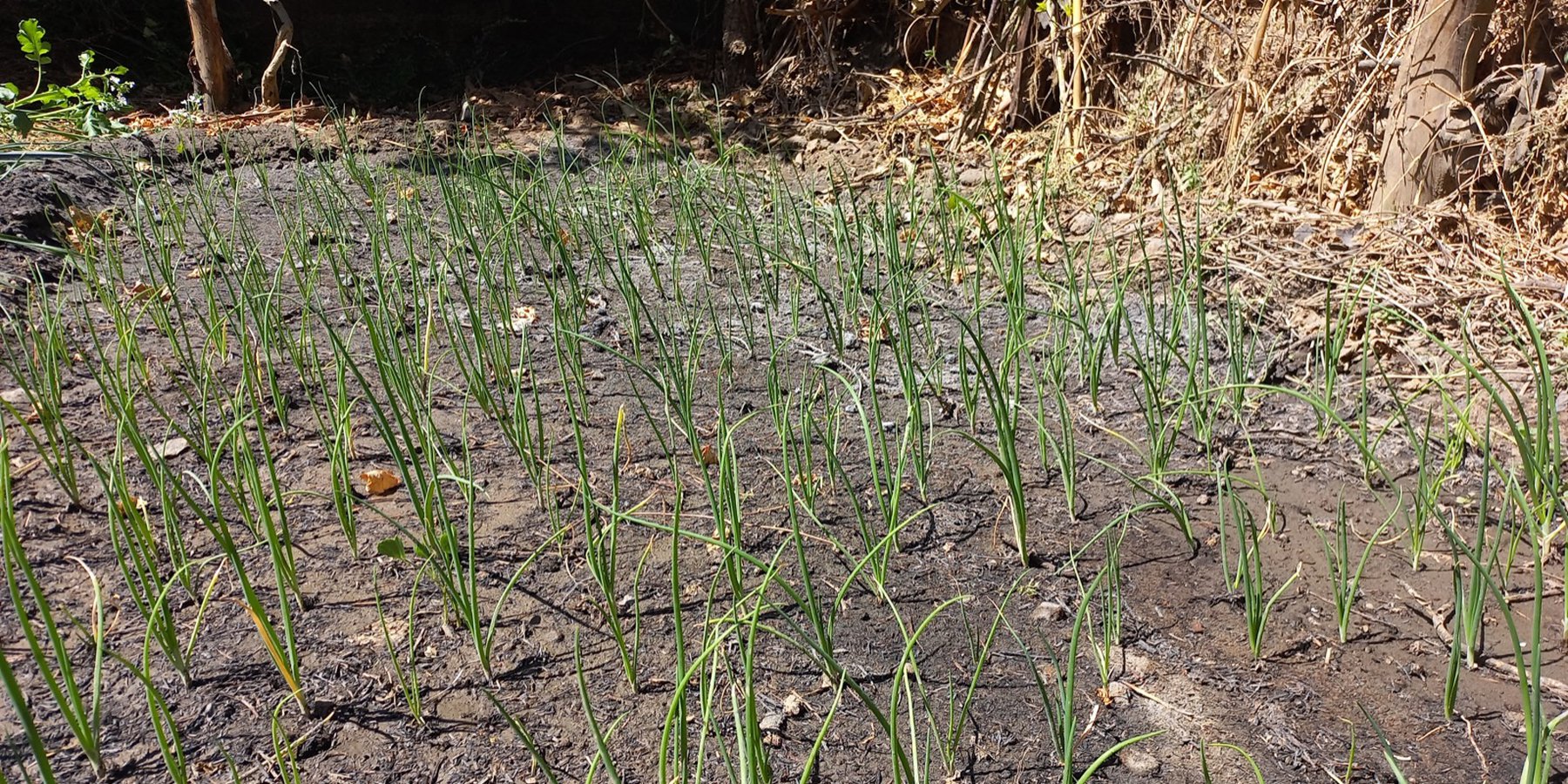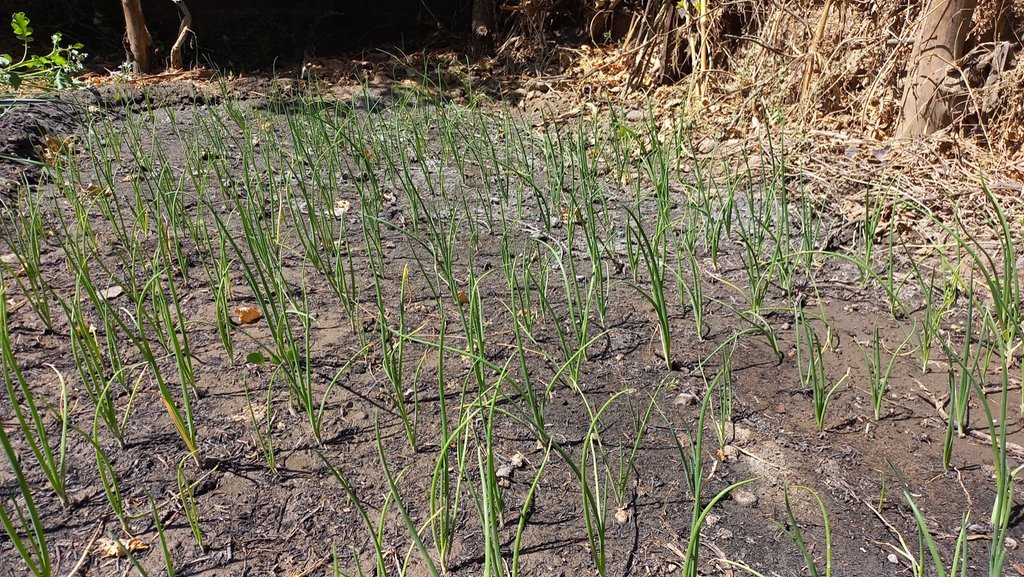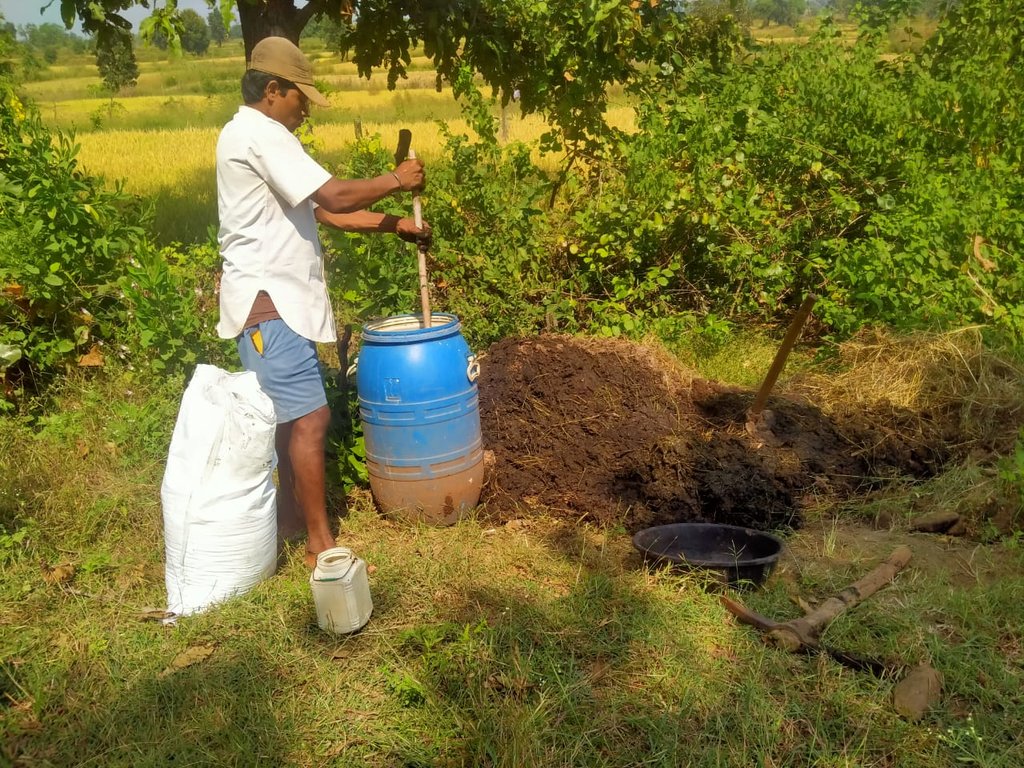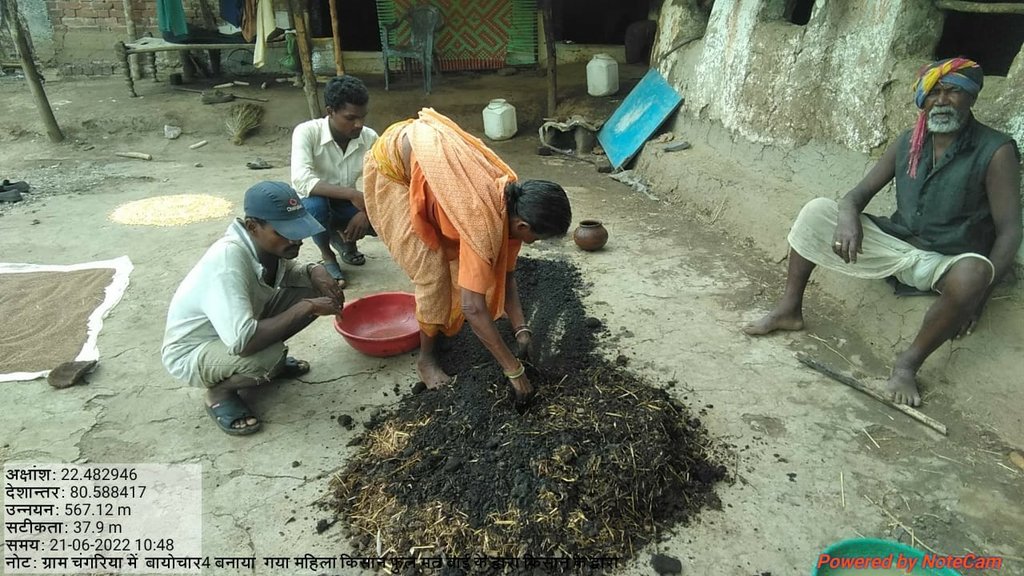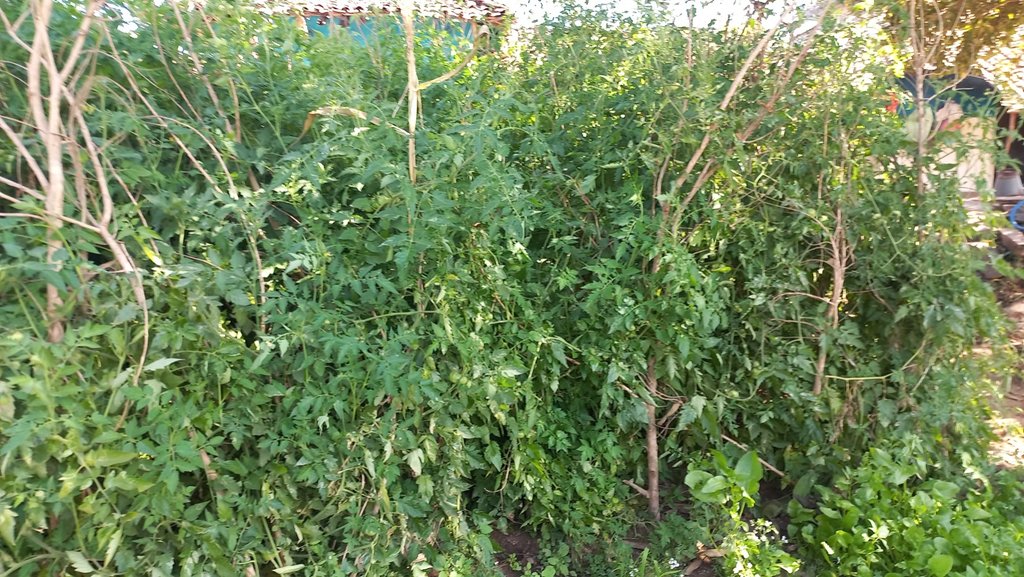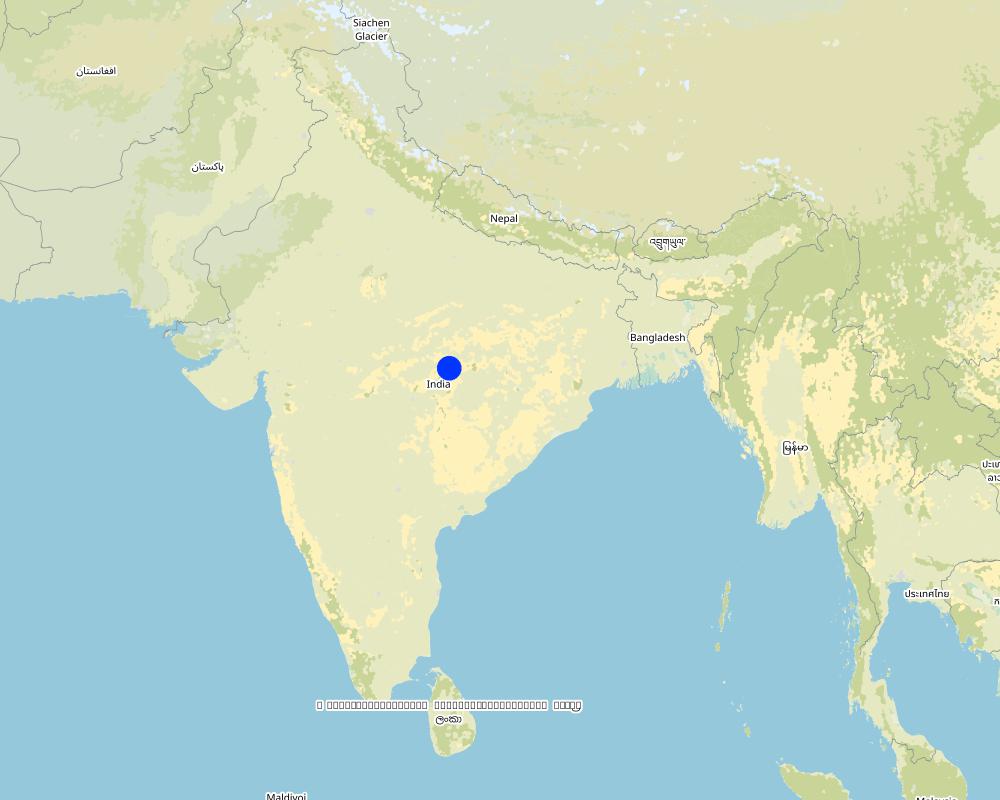Biochar Application on Homestead Land [ອິນເດຍ]
- ການສ້າງ:
- ປັບປູງ:
- ຜູ້ສັງລວມຂໍ້ມູນ: Santosh Gupta
- ບັນນາທິການ: Noel Templer, Stephanie Katsir, Kim Arora
- ຜູ້ທົບທວນຄືນ: Udo Höggel
technologies_6693 - ອິນເດຍ
ເບິ່ງພາກສ່ວນ
ຂະຫຍາຍທັງໝົດ ຍຸບທັງໝົດ1. ຂໍ້ມູນທົ່ວໄປ
1.2 ຂໍ້ມູນ ການຕິດຕໍ່ພົວພັນ ຂອງບຸກຄົນທີ່ສໍາຄັນ ແລະ ສະຖາບັນ ທີ່ມີສ່ວນຮ່ວມ ໃນການປະເມີນເອກກະສານ ເຕັກໂນໂລຢີ
ຊື່ໂຄງການ ທີ່ອໍານວຍຄວາມສະດວກ ໃນການສ້າງເອກກະສານ/ປະເມີນ ເຕັກໂນໂລຢີ (ຖ້າກ່ຽວຂ້ອງ)
Soil protection and rehabilitation for food security (ProSo(i)l)ຊື່ສະຖາບັນ (ຫຼາຍສະຖາບັນ) ທີ່ອໍານວຍຄວາມສະດວກ ໃນການສ້າງເອກກະສານ / ປະເມີນ ເຕັກໂນໂລຢີ (ຖ້າກ່ຽວຂ້ອງ)
GIZ India (GIZ India) - ອິນເດຍຊື່ສະຖາບັນ (ຫຼາຍສະຖາບັນ) ທີ່ອໍານວຍຄວາມສະດວກ ໃນການສ້າງເອກກະສານ / ປະເມີນ ເຕັກໂນໂລຢີ (ຖ້າກ່ຽວຂ້ອງ)
Alliance Bioversity and International Center for Tropical Agriculture (Alliance Bioversity-CIAT) - ເຄັນຢາຊື່ສະຖາບັນ (ຫຼາຍສະຖາບັນ) ທີ່ອໍານວຍຄວາມສະດວກ ໃນການສ້າງເອກກະສານ / ປະເມີນ ເຕັກໂນໂລຢີ (ຖ້າກ່ຽວຂ້ອງ)
Ecociate Consultants (Ecociate Consultants) - ອິນເດຍ1.3 ເງື່ອນໄຂ ກ່ຽວກັບ ການນໍາໃຊ້ຂໍ້ມູນເອກະສານ ທີ່ສ້າງຂື້ນ ໂດຍຜ່ານ ອົງການພາບລວມຂອງໂລກ ທາງດ້ານແນວທາງ ແລະ ເຕັກໂນໂລຢີ ຂອງການອານຸລັກ ທໍາມະຊາດ (WOCAT)
ຜູ້ປ້ອນຂໍ້ມູນ ແລະ ບຸກຄົນສຳຄັນ ທີ່ໃຫ້ຂໍ້ມູນ (ຫຼາຍ) ຍິນຍອມ ຕາມເງື່ອນໄຂ ໃນການນຳໃຊ້ຂໍ້ມູນ ເພື່ອສ້າງເປັນເອກກະສານຂອງ WOCAT:
ແມ່ນ
1.4 ແຈ້ງການວ່າ ດ້ວຍຄວາມຍືນຍົງຂອງ ເຕັກໂນໂລຢີ
ການນໍາໃຊ້ ເຕັກໂນໂລຢີ ດັ່ງກ່າວໄດ້ອະທິບາຍ ເຖິງບັນຫາ ກ່ຽວກັບ ການເຊື່ອມໂຊມຂອງດິນບໍ? ຖ້າບໍ່ດັ່ງນັ້ນ ມັນບໍ່ສາມາດ ຢັ້ງຢືນໄດ້ວ່າ ເປັນເຕັກໂນໂລຊີ ໃນການຄຸ້ມຄອງ ທີ່ດິນແບບຍືນຍົງ? :
ບໍ່ແມ່ນ
ຄວາມຄິດເຫັນ:
The technology described here is the application of biochar on homestead land. This technology positively impacts soil health and crop production.
2. ການອະທິບາຍ ເຕັກໂນໂລຢີ ຂອງການຄຸ້ມຄອງ ທີ່ດິນແບບຍືນຍົງ
2.1 ຄໍາອະທິບາຍສັ້ນຂອງ ເຕັກໂນໂລຢີ
ການກຳໜົດຄວາມໝາຍ ຂອງເຕັກໂນໂລຢີ:
Biochar is a carbon-rich solid formed from the organic residue by pyrolysis. Biochar is a stable, highly water and nutrient-retentive product that benefits microorganisms and has a very high carbon sequestration potential. Farmers in the project area have applied it to their homesteads or kitchen gardens.
2.2 ການອະທິບາຍ ລາຍລະອຽດ ຂອງເຕັກໂນໂລຢີ
ການພັນລະນາ:
Biochar, a sustainable soil amendment, is produced through pyrolysis, where organic matter such as wood or agricultural waste is heated in a closed container under low-oxygen conditions. Applying biochar to soil has numerous benefits for improving soil health, such as enhancing soil fertility, reducing greenhouse gas emissions, improving soil microbiology, and reducing soil erosion. One of the most significant benefits of biochar is its ability to sequester atmospheric carbon dioxide into the soil, which can help mitigate climate change by reducing the amount of carbon dioxide in the atmosphere. Biochar can also remove contaminants from soil and water and serve as a compost component.
Biochar also reduces the emission of ammonia and carbon dioxide (Cabeza et al. 2018), lowers soil compactness, optimizes compost (Liang et al. 2010), improves water retention and the sorption of heavy metals, increases the availability of micronutrients for plants and increases the pH of soils (Van Zwieten et al. 2010). Biochar also stimulates the growth of rhizosphere microorganisms and mycorrhizal fungi (Głuszek et al. 2017). These bacteria and fungi may also promote plant growth (Compant et al. 2010). The pH values of biochars are positively correlated with the formation of carbonates and the contents of inorganic alkalis (Ding et al. 2014). The pH value of biochar ranges from 6.5 to 10.8. It is advisable to test the pH values of both soils and biochar to reach at the optimal quantity of biochar to be applied in the field.
In the Mandla district, agriculture is the backbone of the economy, and farmers are constantly adopting new farming technologies to increase their agricultural production. One such technology that has positively impacted more than a thousand farmers in the region is the application of biochar in homestead land under a GIZ-funded Soil protection and rehabilitation of degraded soil for food security in India (ProSoil) program. Biochar in this region is prepared using low cost Biochar Kiln units developed by Indian council of agriculture research institutions, traditional methods, such as digging soil pits and burning organic residue while covering its top with soil. Since the Mandla district is a high-rainfall region, most farmers broadcast biochar over their fields before growing rabi (winter) crops. Commonly grown rabi crops in this region are mustard, vegetables, and maize.
Farmers in the Mandla district use small units of biochar production. The recovery rate of biochar is 20%, with a capacity of 100kg of organic material. The application rate per unit area varies from farmer to farmer.
1. Landholding: Farmers with more extensive land holdings or generally rotationally applied biochar in the parcels.
2. The intervention of biochar application was introduced in this region in 2020. The new practice is evolving, and the application rate of biochar varies from farmer to farmer depending on the availability of raw materials and labour availability (family/hired)
The most suitable biochar application rate is 10 − 20 t/ha. Moreover, it is essential to consider the compatibility and complementarity between biochar, soil texture, and management factors such as Nitrogen (N) application rate, pH values and growing environment into consideration (Yang Gao et al., 2021). More scientific studies are needed to define the quantity of biochar needed based on the local soil conditions. However, the current quantity of applications is very low compared to suggested in secondary documents.
The immediate effects of biochar application on crop production have been significant, with farmers reporting an increase in crop yield by 20-25% across most crops. Simple indicators such as increased grain weight and improved grain quality imply that the crop produced is of higher quality. Another critical benefit highlighted by farmers of biochar application is the retention of soil moisture over a longer duration compared to non-treated fields. Biochar can help the farmers of the Mandla district increase their agricultural productivity while promoting sustainable land use practices.
2.3 ຮູບພາບຂອງເຕັກໂນໂລຢີ
ຂໍ້ສັງເກດທົ່ວໄປທີ່ກ່ຽວກັບຮູບພາບ:
All the photos have been taken with the consent of participants
2.5 ປະເທດ / ເຂດ / ສະຖານທີ່ບ່ອນທີ່ ເຕັກໂນໂລຢີ ໄດ້ຮັບການນໍາໃຊ້ ແລະ ທີ່ຖືກປົກຄຸມດ້ວຍການປະເມີນຜົນ
ປະເທດ:
ອິນເດຍ
ພາກພື້ນ / ລັດ / ແຂວງ:
Madhya Pradesh
ຂໍ້ມູນເພີ່ມເຕີມຂອງສະຖານທີ່:
Mandla
ໃຫ້ລະບຸ ການແຜ່ຂະຫຍາຍ ເຕັກໂນໂລຢີ:
- ນໍາໃຊ້ໃນຈຸດສະເພາະ / ແນໃສ່ນໍາໃຊ້ໃນພື້ນທີ່ຂະໜາດນ້ອຍ
ສ່ວນຫຼາຍສະຖານທີ່ຕັ້ງຂອງເຕັກໂນໂລຢີ ແມ່ນ ຢູ່ໃນເຂດພື້ນທີ່ສະຫງວນບໍ?
ບໍ່ແມ່ນ
ຄວາມຄິດເຫັນ:
Field visits in Gabri and Changariya villages of Bichhhiya block were conducted to understand the technology
Map
×2.6 ວັນທີໃນການຈັດຕັ້ງປະຕິບັດ
ໃຫ້ລະບຸປີ ໃນການຈັດຕັ້ງປະຕິບັດ:
2020
2.7 ການນໍາສະເໜີ ເຕັກໂນໂລຢີ
ໃຫ້ລະບຸ ເຕັກໂນໂລຢີ ໄດ້ຖືກຈັດຕັ້ງປະຕິບັດຄືແນວໃດ?
- ໃນໄລຍະການທົດລອງ / ການຄົ້ນຄວ້າ
- ໂດຍຜ່ານໂຄງການ / ການຊ່ວຍເຫຼືອຈາກພາຍນອກ
ຄວາມຄິດເຫັນ (ປະເພດ ໂຄງການ ແລະ ອື່ນໆ):
The application of biochar for improving soil health and crop production was introduced in this region through the GIZ-funded program
3. ການໃຈ້ແຍກ ເຕັກໂນໂລຢີ ໃນການຄຸ້ມຄອງ ດິນແບບຍືນຍົງ
3.1 ຈຸດປະສົງຫຼັກ (ຫຼາຍ) ຂອງເຕັກໂນໂລຢີ
- ປັບປຸງ ການຜະລິດ
- ຫຼຸດຜ່ອນ, ປ້ອງກັນ, ຟື້ນຟູ ການເຊື່ອມໂຊມຂອງດິນ
- ການອະນຸລັກ ລະບົບນິເວດ
- ຫຼຸດຜ່ອນຜົນກະທົບ ຈາກການປ່ຽນແປງດິນຟ້າອາກາດ
- ສ້າງຜົນກະທົບ ທາງເສດຖະກິດ ທີ່ເປັນປະໂຫຍດ
3.2 ປະເພດການນໍາໃຊ້ທີ່ດິນ ໃນປະຈຸບັນ() ທີ່ເຕັກໂນໂລຢີ ໄດ້ຖືກນໍາໃຊ້
ການນຳໃຊ້ທີ່ດິນ ປະສົມພາຍໃນພື້ນທີ່ດຽວກັນ:
ແມ່ນ
ລະບຸການນຳໃຊ້ທີ່ດິນແບບປະສົມ (ຜົນລະປູກ / ທົ່ງຫຍ້າລ້ຽງສັດ / ຕົ້ນໄມ້):
- ກະສິກໍາ-ປ່າໄມ້ ແບບປະສົມປະສານ

ດິນທີ່ປູກພືດ
- ການປູກພືດປະຈໍາປີ
ການປູກພືດປະຈຳປີ - ລະບຸປະເພດພືດ:
- ທັນຍາພືດ-ສາລີ
- ທັນຍາພືດ-ເຂົ້າຟາງ
- ທັນຍາພືດ-ເຂົ້ານາ
- ທັນຍາພືດ-ເຂົ້າຟາງ
- legumes and pulses - lentils
- Mustard
ຈໍານວນ ລະດູການ ປູກໃນປີໜຶ່ງ:
- 2
ລະບຸ ຊະນິດ:
Mandla district is predominantly a rainfed region. Homestead land generally has some irrigation facilities available for Kharif (summer) and Rabi (winter) crops.
ມີການເຝືກປູກພືດແບບສັບຫວ່າງບໍ່?
ບໍ່ແມ່ນ
ມີການເຝືກປູກພືດແບບໝູນວຽນບໍ່?
ແມ່ນ
ຖ້າແມ່ນ, ໃຫ້ລະບຸແຈ້ງ:
Vegetable crops such as leafy vegetables, tomatoes, onions, tuber crops, mustard, and maize are commonly grown by farmers. The primary purpose of growing crops on homestead land is to fulfill household-level nutritional requirements.
ຄວາມຄິດເຫັນ:
As per the district census handbook of Mandla District 2001, the land use pattern of Mandla District is: 61% - under forest area, 21% - cropped area, 5% - not available for cultivation, 7% - under fallow land, and 2% - cultivable area. The net area irrigated is 7% of the net area sown, which has hardly increased in recent times (~9%).
3.3 ການນຳໃຊ້ທີ່ດິນ ມີການປ່ຽນແປງຍ້ອນການຈັດຕັ້ງທົດລອງເຕັກໂນໂລຢີ ແມ່ນບໍ່?
ການນຳໃຊ້ທີ່ດິນ ມີການປ່ຽນແປງຍ້ອນການຈັດຕັ້ງທົດລອງເຕັກໂນໂລຢີ ແມ່ນບໍ່?
- ບໍ່ (ຕໍ່ເໜືອງກັບ ຄຳຖາມ 3.4)
ຄວາມຄິດເຫັນ:
There has been no change in land use pattern due to project interventions.
3.4 ການສະໜອງນ້ຳ
ການສະໜອງນໍ້າ ໃນພື້ນທີ່ ທີ່ໄດ້ນໍາໃຊ້ ເຕັກໂນໂລຢີ:
- ປະສົມປະສານ ກັນລະຫວ່າງ ນໍ້າຝົນ ແລະ ນໍ້າຊົນລະປະທານ
ຄວາມຄິດເຫັນ:
Mandla has nearly 9% of its net sown area irrigated. The homestead land, where biochar is applied during the rabi season, has some irrigation from surface- or groundwater sources.
3.5 ການນໍາໃຊ້ເຕັກໂນໂລຢີ ທີ່ຢູ່ໃນກຸ່ມການຄຸ້ມຄອງ ທີ່ດິນແບບຍືນຍົງ
- ກະສິກໍາ-ປ່າໄມ້ ແບບປະສົມປະສານ
- ການປັບປຸງດິນ / ພືດຄຸມດິນ
- ການຈັດການອຸດົມສົມບູນ ຂອງດິນປະສົມປະສານ
3.6 ມາດຕະການ ການຄຸ້ມຄອງ ທີ່ດິນແບບຍືນຍົງ ປະກອບດ້ວຍ ເຕັກໂນໂລຢີ

ມາດຕະການ ທາງການກະສິກໍາ
- A1: ພືດ / ການປົກຫຸ້ມຂອງດິນ
- A2: ອິນຊີວັດຖຸ ຫຼື ຄວາມອຸດົມສົມບູນໃນດິນ

ມາດຕະການ ທາງດ້ານການຄຸ້ມຄອງ
- M2: ການປ່ຽນແປງ ການຈັດການຄຸ້ມຄອງ / ລະດັບຄວາມໜາແໜ້ນ
ຄວາມຄິດເຫັນ:
The application of biochar in the field has improved the water-holding capacity of the soil along with enhanced microbial activities. This has resulted in better and long-duration vegetation as farmers are in position to cultivate vegetables throughout the year.
3.7 ປະເພດດິນເຊື່ອມໂຊມ ຫຼັກທີ່ໄດ້ນໍາໃຊ້ ເຕັກໂນໂລຢີ

ດິນເຊາະເຈື່ອນ ໂດຍນໍ້າ
- Wt: ການສູນເສຍຊັ້ນໜ້າດິນ / ການເຊາະເຈື່ອນຜິວໜ້າດິນ

ການເຊື່ອມໂຊມ ຂອງດິນ ທາງເຄມີ
- Cp: ດິນເປັນມົນລະພິດ

ການເຊື່ອມໂຊມ ຂອງດິນ ທາງກາຍະພາບ
- Pc: ການອັດແໜ້ນ
- Pu: ການສູນເສຍ ການທໍາງານ ຂອງຊີວະພາບຜົນຜະລິດ ເນື່ອງຈາກການກິດຈະກໍາອື່ນໆ

ການເຊື່ອມໂຊມ ທາງຊີວະພາບ
- Bc: ການຫຼຸດຜ່ອນການປົກຫຸ້ມຂອງພືດ
- Bl: ການສູນເສຍ ຈຸລິນຊີໃນດິນ
ຄວາມຄິດເຫັນ:
Biochar acts as soil amendment which helps in improving soil health and status of nutrients in the soil. Some studies have also suggested increase in soil organic carbon as a result of biochar application. Farmers in the project area were also advised to reduce the tillage practices to minimise the soil disturbance.
3.8 ການປ້ອງກັນ, ການຫຼຸດຜ່ອນ, ຫຼືການຟື້ນຟູຂອງການເຊື່ອມໂຊມຂອງດິນ
ໃຫ້ລະບຸ ເປົ້າໝາຍ ເຕັກໂນໂລຢີ ທີ່ພົວພັນ ກັບຄວາມເຊື່ອມໂຊມຂອງດິນ:
- ປ້ອງກັນການເຊື່ອມໂຊມຂອງດິນ
- ຫຼຸດຜ່ອນການເຊື່ອມໂຊມຂອງດິນ
ຄວາມຄິດເຫັນ:
Prior to the application of biochar, farmers were applying synthetic fertilisers and pesticide which was degrading the land. The replacement of synthetic fertilisers with Biochar (also FYM and cow urine mixed with it) has prevented further soil degradation.
4. ຂໍ້ກໍາໜົດ, ກິດຈະກໍາການປະຕິບັດ, ວັດຖຸດິບ, ແລະຄ່າໃຊ້ຈ່າຍ
4.1 ເຕັກນິກ ໃນການແຕ້ມແຜນວາດ ເຕັກໂນໂລຢີ
ຄຸນລັກສະນະ ຂອງເຕັກນິກ (ທີ່ກ່ຽວຂ້ອງ ກັບການແຕ້ມແຜນວາດ ທາງດ້ານເຕັກນີກ):
The drawing presented here is of a biochar kiln unit being developed by the Central Research Institute for Dryland Agriculture (CRIDA) in India for Biochar preparation. A similar unit was used by the land users in the project area. There were some farmers who also did some modifications to make it friendly for the local context. More details about this unit can be obtained from the following sources.
http://www.nicra-icar.in/nicrarevised/images/Books/Biochor%20Bulletin.pdf
http://icar-crida.res.in/Pubs/Biochar%20Research%20Bulletin%20March%202018.pdf (for a description of the HOW to make biochar)
ຜູ້ຂຽນ:
Central Research Institute for Dryland Agriculture (CRIDA)
4.2 ຂໍ້ມູນທົ່ວໄປກ່ຽວກັບການຄິດໄລ່ປັດໃຈຂາເຂົ້າໃນການຜະລິດ ແລະ ມູນຄ່າອື່ນໆ
ລະບຸ ວິທີການ ຄຳໃຊ້ຈ່າຍ ແລະ ປັດໄຈນໍາເຂົ້າ ທີ່ໄດ້ຄິດໄລ່:
- ຕໍ່ພື້ນທີ່ ທີ່ໄດ້ຈັດຕັ້ງປະຕິບັດ ເຕັກໂນໂລຢີ
ໃຫ້ລະບຸຫົວໜ່ວຍ ຂະໜາດ ແລະ ເນື້ອທີ່:
1 Ha
ສະກຸນເງິນອື່ນໆ / ປະເທດອື່ນໆ (ລະບຸ):
INR
ຖ້າກ່ຽວຂ້ອງ, ໃຫ້ລະບຸອັດຕາແລກປ່ຽນຈາກ USD ເປັນສະກຸນເງິນທ້ອງຖິ່ນ (ເຊັ່ນ: 1 USD = 79.9 Brazilian Real): 1 USD =:
82.5
ລະບຸ ຄ່າຈ້າງ ຄ່າແຮງງານສະເລ່ຍ ຕໍ່ ວັນ:
204
4.3 ການສ້າງຕັ້ງກິດຈະກໍາ
| ກິດຈະກໍາ | Timing (season) | |
|---|---|---|
| 1. | Purchase of Biochar Kiln Unit | Once in 4-5 years |
ຄວາມຄິດເຫັນ:
Since it's a seasonal activity there are not many activities which can be categorised here.
4.4 ຕົ້ນທຶນ ແລະ ປັດໄຈຂາເຂົ້າທີ່ຈໍາເປັນໃນຈັດຕັ້ງປະຕິບັດ
| ລະບຸ ປັດໃຈ ນໍາເຂົ້າ ໃນການຜະລີດ | ຫົວໜ່ວຍ | ປະລິມານ | ຕົ້ນທຶນ ຕໍ່ຫົວໜ່ວຍ | ຕົ້ນທຶນທັງໝົດ ຂອງປັດໃຈຂາເຂົ້າ ໃນການຜະລິດ | % ຂອງຕົ້ນທຶນທັງໝົດ ທີ່ຜູ້ນໍາໃຊ້ທີ່ດິນ ໃຊ້ຈ່າຍເອງ | |
|---|---|---|---|---|---|---|
| ອຸປະກອນ | Biochar Kiln unit | Number | 1.0 | 9000.0 | 9000.0 | 10.0 |
| ອຸປະກອນ | Transportation | LS | 1.0 | 2000.0 | 2000.0 | 10.0 |
| ຕົ້ນທຶນທັງໝົດ ໃນການຈັດຕັ້ງປະຕິບັດ ເຕັກໂນໂລຢີ | 11000.0 | |||||
| ຄ່າໃຊ້ຈ່າຍທັງໝົດ ສຳລັບການສ້າງຕັ້ງເຕັກໂນໂລຢີ ເປັນສະກຸນເງີນໂດລາ | 133.33 | |||||
ຖ້າຫາກຜູ້ນຳໃຊ້ທີ່ດິນ ນຳໃຊ້ມູນຄ່າຕ່ຳກວ່າ 100% ໃຫ້ລະບຸ ແມ່ນໃຜເປັນຜູ້ຊ່ວຍ ໃນລາຍຈ່າຍທີ່ເຫຼືອ:
Project has financially supported the local environment committes in purchase and setting up of the Biochar Kiln units
ຄວາມຄິດເຫັນ:
Biochar is prepared by a low-cost method:
1. Using Soil pit kiln - Human Labor cost is usually applied as no capital cost is involved in this method.
2. Using Portable Kiln - Its cost generally range from 12000 -14000 Rs if purchased from the ICAR institutions and their associated fabricators. Sometimes farmers also get it made from the local fabricators which cost Rs 4000-6000
Refer to the following Study: Biochar production from Lantana camara (invasive species);-
https://qcat.wocat.net/en/wocat/technologies/view/technologies_6690/
4.5 ບໍາລຸງຮັກສາ / ແຜນຈັດຕັ້ງປະຕິບັດ ກິດຈະກໍາ
| ກິດຈະກໍາ | ໄລຍະເວລາ / ຄວາມຖີ່ | |
|---|---|---|
| 1. | Preparation of Biochar using the Lantana Camara | After the monsoon season (September) |
| 2. | Preparing the biochar for application by mixing it with cow dung and cow urine | During Rabi Season (Oct-Nov) |
| 3. | Application of Biochar in homestead land | During Rabi Season (Oct-Nov) |
ຄວາມຄິດເຫັນ:
A low-cost method of biochar preparation (traditional soil pit or portable kiln method) is used for biochar preparation. Due to simplicity in design, barely any cost is involved in the maintenance of the unit.
4.6 ຄ່າໃຊ້ຈ່າຍ ແລະ ປັດໄຈນໍາເຂົ້າທີ່ຈໍາເປັນສໍາລັບການບໍາລຸງຮັກສາກິດຈະກໍາ / ແຜນປະຕິບັດ (ຕໍ່ປີ)
| ລະບຸ ປັດໃຈ ນໍາເຂົ້າ ໃນການຜະລີດ | ຫົວໜ່ວຍ | ປະລິມານ | ຕົ້ນທຶນ ຕໍ່ຫົວໜ່ວຍ | ຕົ້ນທຶນທັງໝົດ ຂອງປັດໃຈຂາເຂົ້າ ໃນການຜະລິດ | % ຂອງຕົ້ນທຶນທັງໝົດ ທີ່ຜູ້ນໍາໃຊ້ທີ່ດິນ ໃຊ້ຈ່າຍເອງ | |
|---|---|---|---|---|---|---|
| ແຮງງານ | Transportation of biomass and its drying before biochar production | Person-day | 2.0 | 200.0 | 400.0 | 100.0 |
| ແຮງງານ | Preparation of Biochar by family members | Person-day | 2.0 | 200.0 | 400.0 | 100.0 |
| ແຮງງານ | Mixing biochar with cow dung and cow urine and making it ready for the application | Person-day | 1.0 | 200.0 | 200.0 | 100.0 |
| ແຮງງານ | Biochar Application | Person-day | 1.0 | 200.0 | 200.0 | 100.0 |
| ຝຸ່ນ ແລະ ຢາຊີວະພາບ | Biomass for Biochar production (Approximate) | 1.0 | 500.0 | 500.0 | 100.0 | |
| ຝຸ່ນ ແລະ ຢາຊີວະພາບ | Cow dung | kg | 20.0 | 5.0 | 100.0 | 100.0 |
| ຝຸ່ນ ແລະ ຢາຊີວະພາບ | Cow urine | kg | 20.0 | 5.0 | 100.0 | 100.0 |
| ຕົ້ນທຶນທັງໝົດ ທີ່ໃຊ້ໃນການບໍາລຸງຮັກສາ ເຕັກໂນໂລຢີ | 1900.0 | |||||
| ຄ່າໃຊ້ຈ່າຍທັງໝົດ ສຳລັບການບົວລະບັດຮກສາເຕັກໂນໂລຢີ ເປັນສະກຸນເງີນໂດລາ | 23.03 | |||||
ຄວາມຄິດເຫັນ:
A majority of the cost mentioned here is an opportunity cost for the farmers as they do manage all these expenses internally with available family labour and input materials such as cow dung, cow urine biomass etc.
4.7 ປັດໄຈ ທີ່ສໍາຄັນ ທີ່ສົ່ງຜົນກະທົບ ຕໍ່ຄ່າໃຊ້ຈ່າຍ
ໃຫ້ອະທິບາຍ ປັດໃຈ ທີ່ສົ່ງຜົນກະທົບ ຕໍ່ຕົ້ນທຶນ ໃນການຈັດຕັ້ງປະຕິບັດ:
The primary factor affecting the cost is the labor cost for applying biochar to the field and the easy availability of biomass/crop residues/Lantana for biochar production
5. ສະພາບແວດລ້ອມທໍາມະຊາດ ແລະ ມະນຸດ
5.1 ອາກາດ
ປະລິມານນໍ້າຝົນປະຈໍາປີ
- < 250 ມີລິແມັດ
- 251-500 ມີລິແມັດ
- 501-750 ມີລິແມັດ
- 751-1,000 ມີລິແມັດ
- 1,001-1,500 ມີລິແມັດ
- 1,501-2,000 ມີລິແມັດ
- 2,001-3,000 ມີລິແມັດ
- 3,001-4,000 ມີລິແມັດ
- > 4,000 ມີລິແມັດ
ໃຫ້ລະບຸສະເລ່ຍ ປະລິມານນໍ້າຝົນຕົກປະຈໍາປີ ເປັນມິນລິແມັດ (ຖ້າຫາກຮູ້ຈັກ):
1427.70
ຂໍ້ມູນສະເພາະ / ຄວາມເຫັນກ່ຽວກັບ ປະລິມານນໍ້າຝົນ:
Monsoon season is June-September which has the majority of the rainfall
ໃຫ້ລະບຸ ຊື່ສະຖານີ ອຸຕຸນິຍົມ ເພື່ອເປັນຂໍ້ມູນອ້າງອີງ:
District at glance report of Ministry of Water Resources, Central Groundwater Board, North Central Region BHOPAL, 2013
ເຂດສະພາບອາກາດກະສິກໍາ
- ເຄີ່ງຄວາມຊຸ່ມ
- ເຄິ່ງແຫ້ງແລ້ງ
The National Bureau of Soil Survey & Land Use Planning (NBSS&LUP) developed twenty agroecological zones based on the growing period as an integrated criterion of adequate rainfall and soil groups. It delineated boundaries adjusted to district boundaries with a minimal number of regions. Mandla District of Madhya Pradesh lies in a hot sub-humid ecoregion with red and black soil. The length of the growing period varies from block to block based on the availability of irrigation with farmers. Thus both sub-humid and semi-arid agroclimatic zones are being considered for the District.
Precipitation: 1000–1500 mm; Potential Evapotranspiration: 1300–1500 mm; Length of Growing Period: 150–180 days
5.2 ພູມິປະເທດ
ຄ່າສະເລ່ຍ ຄວາມຄ້ອຍຊັນ:
- ພື້ນທີ່ຮາບພຽງ (0-2%)
- ອ່ອນ (3-5 %)
- ປານກາງ (6-10 %)
- ມ້ວນ (11-15 %)
- ເນີນ(16-30%)
- ໍຊັນ (31-60%)
- ຊັນຫຼາຍ (>60%)
ຮູບແບບຂອງດິນ:
- ພູພຽງ / ທົ່ງພຽງ
- ສັນພູ
- ເປີ້ນພູ
- ເນີນພູ
- ຕີນພູ
- ຮ່ອມພູ
ເຂດລະດັບສູງ:
- 0-100 ແມັດ a.s.l.
- 101-500 ແມັດ a.s.l.
- 501-1,000 ແມັດ a.s.l.
- 1,001-1,500 ແມັດ a.s.l.
- 1,501-2,000 ແມັດ a.s.l.
- 2,001-2,500 ແມັດ a.s.l.
- 2,501-3,000 ແມັດ a.s.l.
- 3,001-4,000 ແມັດ a.s.l.
- > 4,000 ແມັດ a.s.l.
ໃຫ້ລະບຸ ເຕັກໂນໂລຢີ ທີ່ໄດ້ຖືກນຳໃຊ້:
- ບໍ່ກ່ຽວຂ້ອງ
ຄຳເຫັນ ແລະ ຂໍ້ມູນສະເພາະ ເພີ່ມເຕີມ ກ່ຽວກັບ ພູມີປະເທດ:
Mandla District is hilly and forested (Satpura hill range) and highly undulating with a narrow strip of cultivated plains in the valley portion of the river and rivulet. The plateau is in the northern part, formed by basalt and east-west trending hills in the southern part. The highest elevation is 934m ASL in the northern region, and the lowest elevation is around 400m ASL.
5.3 ດິນ
ຄວາມເລິກ ຂອງດິນສະເລ່ຍ:
- ຕື້ນຫຼາຍ (0-20 ຊັງຕີແມັດ)
- ຕື້ນ (21-50 ຊຕມ)
- ເລີກປານກາງ (51-80 ຊຕມ)
- ເລິກ (81-120 ຊມ)
- ເລິກຫຼາຍ (> 120 cm)
ເນື້ອດິນ (ໜ້າດິນ):
- ຫຍາບ / ເບົາ (ດິນຊາຍ)
- ປານກາງ (ດິນໜຽວ, ດິນໂຄນ)
ເນື້ອດິນ (ເລິກຈາກໜ້າດິນ ລົງໄປຫຼາຍກວ່າ 20 ຊັງຕິແມັດ):
- ປານກາງ (ດິນໜຽວ, ດິນໂຄນ)
- ບາງລະອຽດ / ໜັກ (ໜຽວ)
ຊັ້ນອິນຊີວັດຖຸ ເທິງໜ້າດິນ:
- ຕໍາ່ (<1 %)
ຖ້າເປັນໄປໄດ້ ແມ່ນໃຫ້ຕິດຄັດ ການພັນລະນາດິນ ຫຼື ຂໍ້ມູນສະເພາະຂອງດິນ, ຕົວຢ່າງ, ຄຸນລັກສະນະ ປະເພດຂອງດິນ, ຄ່າຄວາມເປັນກົດ / ເປັນດ່າງຂອງດິນ, ສານອາຫານ, ດິນເຄັມ ແລະ ອື່ນໆ.
The soils in the area are generally clayey loam types with sandy loam soil in some areas. In the northern and central parts of the District, the undulating plateau with mounds is covered with slightly deep soil. Regarding the classification of ‘Soils of the World,’ the soils of Mandla are characterized as ‘brown earth.’ These types of soils have developed from granite gneiss and quartzite schist complexes.
5.4 ມີນໍ້າ ແລະ ຄຸນນະພາບ
ລະດັບ ນໍ້າໃຕ້ດິນ:
5-50 ແມັດ
ການມີນໍ້າ ເທິງໜ້າດິນ:
ປານກາງ
ຄຸນນະພາບນໍ້າ (ບໍ່ມີການບໍາບັດ):
ບໍ່ມີນໍ້າດື່ມ (ຮຽກຮ້ອງໃຫ້ມີການບຳບັດນ້ຳ)
ຄຸນນະພາບນ້ຳ ໝາຍເຖີງ:
ທັງນ້ຳໃຕ້ດິນ ແລະ ນ້ຳໜ້າດິນ
ມີບັນຫາ ກ່ຽວກັບນໍ້າເຄັມບໍ່?
ບໍ່ແມ່ນ
ເກີດມີນໍ້າຖ້ວມ ໃນພື້ນທີ່ບໍ່?
ບໍ່ແມ່ນ
ຄວາມຄິດເຫັນ ແລະ ຂໍ້ກໍານົດ ເພີ່ມເຕີມ ກ່ຽວກັບ ຄຸນນະພາບ ແລະ ປະລິມານ ຂອງນ້ຳ:
The pre-monsoon groundwater level in the area ranges from 3 to 14 meters below ground level. (District at Glance, Mandla, Central Ground Water Board, 2013). The locations have a river flowing close to the area; however, access to the surface and sub-surface water is a primary concern. Basaltic lava flows of the Deccan trap underlie the Mandla District. All blocks of the district including project block Bichhiya are categorized as safe blocks. The net groundwater availability in the district is 53779 hectare meters (ham), and the groundwater draft for all uses is 8205 ham, making the Stage of Groundwater Development 15% as a whole for the district. The area's topography, soil, and geology do not let water remain for long durations, causing water scarcity in summer. The irrigation facilities are poor and limited to areas adjoining dams and canals.
5.5 ຊີວະນາໆພັນ
ຄວາມຫຼາກຫຼາຍ ທາງສາຍພັນ:
- ສູງ
ຄວາມຫຼາກຫຼາຍ ທາງດ້ານ ທີ່ຢູ່ອາໃສ ຂອງສິ່ງທີ່ມີຊີວິດ:
- ສູງ
ຄວາມຄິດເຫັນ ແລະ ລັກສະນະສະເພາະ ເພີ່ມເຕີມກ່ຽວກັບ ຊີວະນາໆພັນ:
The area is surrounded by the Kanha National Park and Phen Wildlife Sanctuary, with a good presence of forest area. Thus biodiversity is outstanding. Ecological assessment report in Mandla (where this Technology is applied) showed improved biodiversity on common lands under village governance compared to open-access or commons under government ownership. On average, the Shannon diversity index (https://www.statology.org/shannon-diversity-index/) of managed common lands was 1.45 compared to 0.42 for the open access or ungoverned commons. Most of the sites under open access lands are infested by Lantana camara, which is the main reason for the lower biomass and diversity of the ungoverned grounds. More information about the biodiversity in Mandla can be read through the following link.
https://mpsbb.mp.gov.in/completedProject/MB.pdf
5.6 ຄຸນລັກສະນະ ຂອງຜູ້ນໍາໃຊ້ທີ່ດິນ ທີ່ໄດ້ນໍາໃຊ້ເຕັກໂນໂລຢີ
ຢູ່ປະຈຳ ຫຼື ເຄື່ອນຍ້າຍຕະຫຼອດ:
- ບໍ່ເຄື່ອນໄຫວ
ລະບົບ ການຕະຫຼາດ ແລະ ຜົນຜະລິດ:
- ປະສົມປົນເປ( ກຸ້ມຕົນເອງ/ເປັນສິນຄ້າ)
ລາຍຮັບ ທີ່ບໍ່ໄດ້ມາຈາກ ການຜະລິດ ກະສິກໍາ:
- > 50 % ຂອງລາຍຮັບທັງໝົດ
ລະດັບຄວາມຮັ່ງມີ:
- ທຸກຍາກ
- ສະເລ່ຍ
ບຸກຄົນ ຫຼື ກຸ່ມ:
- ບຸກຄົນ / ຄົວເຮືອນ
ລະດັບ ການຫັນເປັນກົນຈັກ:
- ການໃຊ້ແຮງງານຄົນ
- ສັດລາກແກ່
ເພດ:
- ຜູ້ຍິງ
- ຜູ້ຊາຍ
ອາຍຸ ຂອງຜູ້ນໍາໃຊ້ທີ່ດິນ:
- ຊາວໜຸ່ມ
- ໄວກາງຄົນ
ໃຫ້ລະບຸ ຄຸນລັກສະນະ ຂອງຜູ້ນໍາໃຊ້ທີ່ດິນ:
A large majority of the user belonging to the tribal community, including some households from an ethnic community called Baiga.
5.7 ເນື້ອທີ່ສະເລ່ຍຂອງດິນ ທີ່ຜູ້ນຳໃຊ້ທີ່ດິນ ໃຊ້ເຮັດເຕັກໂນໂລຢີ
- <0.5 ເຮັກຕາ
- 0.5-1 ເຮັກຕາ
- 1-2 ເຮັກຕາ
- 2-5 ເຮັກຕາ
- 5-15 ເຮັກຕາ
- 15-50 ເຮັກຕາ
- 50-100 ເຮັກຕາ
- 100-500 ເຮັກຕາ
- 500-1,000 ເຮັກຕາ
- 1,000-10,000 ເຮັກຕາ
- > 10,000 ເຮັກຕາ
ຖືໄດ້ວ່າ ເປັນຂະໜາດນ້ອຍ, ກາງ ຫຼື ໃຫຍ່ (ອີງຕາມເງື່ອນໄຂ ສະພາບຄວາມເປັນຈິງ ຂອງທ້ອງຖີ່ນ)? :
- ຂະໜາດນ້ອຍ
ຄວາມຄິດເຫັນ:
Around 2000 farmers in different crops have applied the technology
5.8 ເຈົ້າຂອງທີ່ດິນ, ສິດໃຊ້ທີ່ດິນ, ແລະ ສິດທິການນໍາໃຊ້ນໍ້າ
ເຈົ້າຂອງດິນ:
- ຊຸມຊົນ / ບ້ານ
- ບຸກຄົນ, ທີ່ມີຕໍາແໜ່ງ
ສິດທິ ໃນການນໍາໃຊ້ທີ່ດິນ:
- ບຸກຄົນ
ສິດທິ ໃນການນໍາໃຊ້ນໍ້າ:
- ຊຸມຊົນ (ທີ່ມີການຈັດຕັ້ງ)
- ບຸກຄົນ
ສິດນຳໃຊ້ທີ່ດິນ ແມ່ນ ອີງໃສ່ລະບົບກົດໝາຍແບບດັ້ງເດີມບໍ?
ແມ່ນ
ລະບຸ ຊະນິດ:
The concerned authorities have issued landowners the land certificates.
5.9 ການເຂົ້າເຖິງການບໍລິການ ແລະ ພື້ນຖານໂຄງລ່າງ
ສຸຂະພາບ:
- ທຸກຍາກ
- ປານກາງ
- ດີ
ການສຶກສາ:
- ທຸກຍາກ
- ປານກາງ
- ດີ
ການຊ່ວຍເຫຼືອ ດ້ານວິຊາການ:
- ທຸກຍາກ
- ປານກາງ
- ດີ
ການຈ້າງງານ (ຕົວຢ່າງ, ການເຮັດກິດຈະກໍາອື່ນ ທີ່ບໍ່ແມ່ນ ການຜະລິດກະສິກໍາ):
- ທຸກຍາກ
- ປານກາງ
- ດີ
ຕະຫຼາດ:
- ທຸກຍາກ
- ປານກາງ
- ດີ
ພະລັງງານ:
- ທຸກຍາກ
- ປານກາງ
- ດີ
ຖະໜົນຫົນທາງ ແລະ ການຂົນສົ່ງ:
- ທຸກຍາກ
- ປານກາງ
- ດີ
ການດື່ມນໍ້າ ແລະ ສຸຂາພິບານ:
- ທຸກຍາກ
- ປານກາງ
- ດີ
ການບໍລິການ ທາງດ້ານການເງິນ:
- ທຸກຍາກ
- ປານກາງ
- ດີ
Advisory and extension (limited to only project teams):
- ທຸກຍາກ
- ປານກາງ
- ດີ
ຄວາມຄິດເຫັນ:
Over the years, there has been a development focus from both the Government and other civil society organizations to bring out the facilities at the door of communities, which has improved access of different facilities.
6. ຜົນກະທົບ ແລະ ລາຍງານສະຫຼຸບ
6.1 ການສະແດງຜົນກະທົບ ພາຍໃນພື້ນທີ່ ທີ່ໄດ້ຈັດຕັ້ງປະຕິບັດ ເຕັກໂນໂລຢີ
ຜົນກະທົບທາງເສດຖະກິດສັງຄົມ
ການຜະລິດ
ການຜະລິດພືດ
ຄວາມຄິດເຫັນ / ລະບຸແຈ້ງ:
There has not been any systematic impact assessment study to quantify the impact of the intervention. However, in discussions with farmers and implementing agencies during the field visit, an increase of 20-25% in the production of farm products was reported.
ຄຸນນະພາບຂອງພືດ
ຄວາມຄິດເຫັນ / ລະບຸແຈ້ງ:
Change in crop weight and colour is observed by farmers
ການຈັດການຄຸ້ມຄອງທີ່ດິນ
ຄວາມຄິດເຫັນ / ລະບຸແຈ້ງ:
Improved Soil Health is indicated by farmers based on their observation of improved soil structure, water-holding capacity and soil texture
ລາຍໄດ້ ແລະ ຄ່າໃຊ້ຈ່າຍ
ລາຍຮັບ ຈາກການຜະລີດ
ຄວາມຄິດເຫັນ / ລະບຸແຈ້ງ:
On the account of improved productivity, farmers have reported an increase in their income. However, there has not been any systematic study on the same.
ຜົນກະທົບດ້ານວັດທະນາທໍາສັງຄົມ
ຄວາມຮູ້ກ່ຽວກັບ ການຄຸ້ມຄອງ ທີ່ດິນແບບຍືນຍົງ / ການເຊື່ອມໂຊມຂອງດິນ
ຄວາມຄິດເຫັນ / ລະບຸແຈ້ງ:
The preparation of biochar from invasive species and its application to soil improved the understanding of farmers on the negative impact of invasive species and advantages of biochar application
ຜົນກະທົບຕໍ່ລະບົບນິເວດ
ດິນ
ຄວາມຊຸ່ມຂອງດິນ
ຄວາມຄິດເຫັນ / ລະບຸແຈ້ງ:
Soil structure improved by biochar application, improving water holding capacity of soil
ການສູນເສຍດິນ
ຄວາມຄິດເຫັນ / ລະບຸແຈ້ງ:
Reduction in soil erosion due to improvement in soil structure
ການອັດແໜ້ນຂອງດິນ
ຄວາມຄິດເຫັນ / ລະບຸແຈ້ງ:
Reduction in soil compaction due to improvement in soil structure
ອິນຊີວັດຖຸໃນດິນ / ຢູ່ລຸ່ມຊັ້ນດິນ C
ຄວາມຄິດເຫັນ / ລະບຸແຈ້ງ:
Based on the observation of farmers and implementing agency, random soil tests of farmers have indicated a slight increase in soil organic carbon
ຊີວະນານາພັນ: ສັດ, ພືດ
ສາຍພັນຕ່າງຖີ່ນ
ຄວາມຄິດເຫັນ / ລະບຸແຈ້ງ:
Reduction in invasive alien species named lantana cantara which was uprooted for preparing biochar
ການຫຼຸດຜ່ອນ ຄວາມສ່ຽງ ຈາກໄພພິບັດ ແລະ ອາກາດປ່ຽນແປງ
ການປ່ຽນແປງ ອາກາດ ໃນວົງແຄບ
ຄວາມຄິດເຫັນ / ລະບຸແຈ້ງ:
Improve soil health create an enabling environment for soil micro-organism
ລະບຸ ການປະເມີນຜົນກະທົບ ຕໍ່ສະຖານທີ່ (ການວັດແທກ):
All the indicated impact measures are based on discussions with farmers, implementing agencies and other stakeholders. These were reported as per their observations, eye estimations and approximation.
6.2 ຜົນກະທົບທາງອ້ອມ ຈາກການນໍາໃຊ້ເຕັກໂນໂລຢີ
Biochar is prepared using invasive species of Lantana Camara. Its eradication from private and commercial land improves the ecosystem.
ກໍານົດ ການປະເມີນ ຜົນກະທົບທາງນອກ (ການວັດແທກ):
The scale of implementation is not large enough to have an ecosystem level impact
6.3 ການປ້ອງກັນ ແລະ ຄວາມບອບບາງ ຂອງເຕັກໂນໂລຢິ ໃນການປ່ຽນແປງສະພາບດິນຟ້າອາກາດ ແລະ ກ່ຽວຂ້ອງກັບອາກາດທີ່ມີການປ່ຽນແປງທີ່ຮຸນແຮງ / ໄພພິບັດທາງທໍາມະຊາດ (ຮັບຮູ້ໄດ້ໂດຍຜູ້ນໍາໃຊ້ທີ່ດິນ)
ການປ່ຽນແປງດິນຟ້າອາກາດ ເທື່ອລະກ້າວ
ການປ່ຽນແປງດິນຟ້າອາກາດ ເທື່ອລະກ້າວ
| ລະດູການ | ເພີ່ມຂື້ນ ຫຼື ຫຼຸດລົງ | ການນໍາໃຊ້ ເຕັກໂນໂລຢີ ສາມາດ ຮັບມື ໄດ້ຄືແນວໃດ? | |
|---|---|---|---|
| ການປ່ຽນແປງສະພາບດິນຟ້າອາກາດອື່ນໆ | When biochar is added to soil, it can sequester carbon in the form of stable organic matter, which can remain in the soil for hundreds or even thousands of years. This carbon sequestration can help to reduce the amount of carbon dioxide in the atmosphere, thereby mitigating climate change. | ຫຼຸດລົງ | ດີ |
6.4 ການວິເຄາະຕົ້ນທຶນ ແລະ ຜົນປະໂຫຍດ
ຈະເຮັດປະໂຫຍດເພື່ອປຽບທຽບກັບຄ່າໃຊ້ຈ່າຍກັບສິ່ງກໍ່ສ້າງ (ຈາກທັດສະນະຂອງຜູ້ນຳໃຊ້ທີ່ດິນ) ໄດ້ແນວໃດ?
ຜົນຕອບແທນ ໃນໄລຍະສັ້ນ:
ຜົນກະທົບທາງບວກ
ຜົນຕອບແທນ ໃນໄລຍະຍາວ:
ຜົນກະທົບທາງບວກຫຼາຍ
ຈະໄດ້ຮັບຜົນປະໂຫຍດເມື່ອປຽບທຽບກັບ / ຄ່າໃຊ້ຈ່າຍໃນການບຳລຸງຮັກສາທີເ່ກີດຂື້ນອິກ (ຈາກທັດສະນະຄະຕິຂອງຜູ້ນຳໃຊ້ທີ່ດິນ) ໄດ້ແນວໃດ?
ຜົນຕອບແທນ ໃນໄລຍະສັ້ນ:
ຜົນກະທົບທາງບວກ
ຜົນຕອບແທນ ໃນໄລຍະຍາວ:
ຜົນກະທົບທາງບວກຫຼາຍ
ຄວາມຄິດເຫັນ:
The benefits as indicated above are much higher than the cost involved. More importantly cost is too less as all the resources are being managed internally by the farmers.
6.5 ການປັບຕົວຮັບເອົາເຕັກໂນໂລຢີ
- 1-10%
ຖ້າຫາກວ່າມີ, ປະລິມານ (ຈໍານວນຂອງຄົວເຮືອນ / ເນື້ອທີ່ການຄຸ້ມຄອງ):
More than 3000 farmers
6.7 ຈຸດແຂງ / ຂໍ້ດີ / ໂອກາດ ໃນການນໍາໃຊ້ ເຕັກໂນໂລຢີ
| ຈຸດແຂງ / ຂໍ້ດີ / ໂອກາດໃນການນໍາໃຊ້ທີ່ດິນ |
|---|
| Increase crop production |
| Improve the quality of farm produce |
| Improve soil water holding capacity |
| ຈຸດແຂງ / ຈຸດດີ / ໂອກາດ ຈາກທັດສະນະຂອງຜູ້ປ້ອນຂໍ້ມູນ ຫຼື ບຸກຄົນສຳຄັນ |
|---|
| Improved soil health |
| Mitigate climate change |
| Increase in soil nutrient content |
| Reduction in cost of inputs |
6.8 ຈຸດອ່ອນ / ຂໍ້ເສຍ / ຄວາມສ່ຽງ ໃນການນໍາໃຊ້ ເຕັກໂນໂລຢີ ແລະ ວິທີການແກ້ໄຂບັນຫາ
| ຈຸດອ່ອນ / ຂໍ້ເສຍ / ຄວາມສ່ຽງໃນມຸມມອງຂອງຜູ້ນໍາໃຊ້ທີ່ດິນ | ມີວິທີການແກ້ໄຂຄືແນວໃດ? |
|---|---|
| Manual labor is required for the preparation of biochar | Innovating/adopting automation in biochar preparation |
| Decentralized preparation of biochar | Developing enterprise for selling cost-effective biochar in a localized manner |
| ຈຸດອ່ອນ/ຂໍ້ບົກຜ່ອງ/ຄວາມສ່ຽງ ຈາກທັດສະນະຂອງຜູ້ປ້ອນຂໍ້ມູນ ຫຼື ບຸກຄົນສຳຄັນ | ມີວິທີການແກ້ໄຂຄືແນວໃດ? |
|---|---|
| Limited understanding of standardization of biochar quality and rate of application | Conducting more research studies and documenting experiences of farmers |
7. ເອກະສານອ້າງອີງ ແລະ ການເຊື່ອມຕໍ່
7.1 ວິທີການ / ແຫຼ່ງຂໍ້ມູນ
- ການໄປຢ້ຽມຢາມພາກສະໜາມ, ການສໍາຫຼວດພາກສະໜາມ
1
- ການສໍາພາດ ຜູ້ນໍາໃຊ້ທີ່ດິນ
8
- ສໍາພາດ ຊ່ຽວຊານ ການຄຸ້ມຄອງ ດິນແບບຍືນຍົງ
1
- ການລວບລວມ ບົດລາຍງານ ແລະ ເອກະສານ ອື່ນໆ ທີ່ມີຢູ່ແລ້ວ
3
ເມື່ອໃດທີ່ໄດ້ສັງລວມຂໍ້ມູນ (ຢູ່ພາກສະໜາມ)?
22/02/2023
ຄວາມຄິດເຫັນ:
During the field visit, detailed discussions were held with the project implementing agency, communities, and other stakeholders to understand the process and impact of the intervention
7.2 ເອກກະສານອ້າງອີງທີ່ເປັນບົດລາຍງານ
ຫົວຂໍ້, ຜູ້ຂຽນ, ປີ, ISBN:
Significance of biochar application to the environment and economy, Babalola Aisosa Onia,⁎, Olubukola Oziegbeb, Obembe O. Olawole
ມີຢູ່ໃສ?ມູນຄ່າເທົ່າໃດ?
https://doi.org/10.1016/j.aoas.2019.12.006
ຫົວຂໍ້, ຜູ້ຂຽນ, ປີ, ISBN:
Impacts of biochar application on upland agriculture: A review, Kumuduni Niroshika Palansooriyaa,1, Yong Sik Oka,1, Yasser Mahmoud Awada, Sang Soo Leeb, Jwa-Kyung Sungc, Agamemnon Koutsospyrosd, Deok Hyun Moone
ມີຢູ່ໃສ?ມູນຄ່າເທົ່າໃດ?
https://doi.org/10.1016/j.jenvman.2018.12.085
ຫົວຂໍ້, ຜູ້ຂຽນ, ປີ, ISBN:
The role of biochar and biochar-compost in improving soil quality and crop performance: A review, Getachew Agegnehua,⁎, A.K. Srivastavab, Michael I. Birda
ມີຢູ່ໃສ?ມູນຄ່າເທົ່າໃດ?
http://dx.doi.org/10.1016/j.apsoil.2017.06.008
ຫົວຂໍ້, ຜູ້ຂຽນ, ປີ, ISBN:
Biochar physicochemical properties: pyrolysis temperature and feedstock kind effects
ມີຢູ່ໃສ?ມູນຄ່າເທົ່າໃດ?
https://link.springer.com/article/10.1007/s11157-020-09523-3
7.3 ເຊື່ອມຕໍ່ກັບຂໍ້ມູນທີ່ກ່ຽວຂ້ອງໂດຍກົງ
ຫົວຂໍ້ / ພັນລະນາ:
District at glance - Mandla
URL:
http://cgwb.gov.in/District_Profile/MP/Mandla.pdf
ຫົວຂໍ້ / ພັນລະນາ:
District Census Handbook Mandla
URL:
http://lsi.gov.in:8081/jspui/bitstream/123456789/2097/1/38136_2001_MAN.pdf
ຂໍ້ມູນການເຊື່ອມຕໍ່ ແລະ ເນື້ອໃນ
ຂະຫຍາຍທັງໝົດ ຍຸບທັງໝົດການເຊື່ອມຕໍ່
ບໍ່ມີຂໍ້ມູນການເຊື່ອມຕໍ່
ເນື້ອໃນ
ບໍ່ມີເນື້ອໃນ


